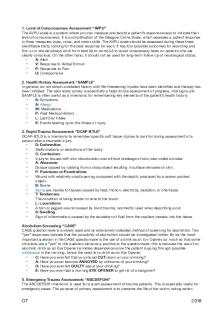Anatomy and Physiology Nursing Mnemonics & Tips PDF

| Title | Anatomy and Physiology Nursing Mnemonics & Tips |
|---|---|
| Course | Diploma of nursing |
| Institution | TAFE New South Wales |
| Pages | 1 |
| File Size | 34.9 KB |
| File Type | |
| Total Downloads | 11 |
| Total Views | 157 |
Summary
Nursing Mnemonics and Tips...
Description
1. Functions of the Bone! The functions of the bones in the human body are abundant and crucial – far above and beyond provision of rigidity. Its functions are further divided into three, namely: mechanical functions which include protection, structure, movement and sound transduction; synthetic function such as blood production; and metabolic functions including mineral, fat and growth storage, acid-base balance, detoxification, and endocrine organ. To summarize these functions, remember the mnemonic “Some Men Prefer Mini Skirts, But Can’t Find Enough Skin.”! 2. Facial Bones: “VAIN MM PLZ”! Textbooks differ as to what bones to include in the facial skeleton, making a strict distinction between bones of the neurocranium and viscerocranium. The hyoid, ethmoid, and sphenoid bones are sometimes included, but otherwise considered part of the neurocranium. Others also include bones that can be seen in the frontal aspect of the skull such as the frontal bone. Note VAIN MM PLZ so you don’t miss out any of the facial bones.! 3. Cranial Bones: “PEST OF”! The neurocranium is comprised of eight bones: occipital, two temporal bones, two parietal bones, sphenoid, ethmoid, and the frontal bone. They form major portions of the skull and protect the brain.! 4. Layers of the Epidermis! Epidermis is the outermost layer of skin. While epithelium is a layer of cells covering most of the organs separately (eg. epithelium of digestive system and epithelium of respiratory system), the epidermis itself consists of a layer of epithelial cells (epithelium). The mnemonic “Come, Let’s Get Sun Burned” will let you not forget the layers of the epidermis.! 5. Functions of the Epithelium:!“PASSIFS”! Epithelium is one of the four basic types of animal tissue, along with connective tissue, muscle tissue and nervous tissue. It refers to layers of cells that line hollow organs and glands. It is also those cells that make up the outer surface of the body. The cells vary in structure according to their function, which may be protective, secretory, or absorptive. Just remember the mnemonic PASSIFS for its functions.!
OT
2018...
Similar Free PDFs

Anatomy-Mnemonics
- 11 Pages

Anatomy Mnemonics
- 7 Pages

Anatomy mnemonics
- 139 Pages

Chicken Anatomy AND Physiology
- 24 Pages

reflex physiology and anatomy
- 4 Pages

Anatomy and Physiology
- 4 Pages

Anatomy-and-physiology
- 197 Pages

Anatomy and Physiology
- 7 Pages

Anatomy and Physiology
- 7 Pages

heart anatomy and physiology
- 4 Pages

anatomy and physiology
- 31 Pages
Popular Institutions
- Tinajero National High School - Annex
- Politeknik Caltex Riau
- Yokohama City University
- SGT University
- University of Al-Qadisiyah
- Divine Word College of Vigan
- Techniek College Rotterdam
- Universidade de Santiago
- Universiti Teknologi MARA Cawangan Johor Kampus Pasir Gudang
- Poltekkes Kemenkes Yogyakarta
- Baguio City National High School
- Colegio san marcos
- preparatoria uno
- Centro de Bachillerato Tecnológico Industrial y de Servicios No. 107
- Dalian Maritime University
- Quang Trung Secondary School
- Colegio Tecnológico en Informática
- Corporación Regional de Educación Superior
- Grupo CEDVA
- Dar Al Uloom University
- Centro de Estudios Preuniversitarios de la Universidad Nacional de Ingeniería
- 上智大学
- Aakash International School, Nuna Majara
- San Felipe Neri Catholic School
- Kang Chiao International School - New Taipei City
- Misamis Occidental National High School
- Institución Educativa Escuela Normal Juan Ladrilleros
- Kolehiyo ng Pantukan
- Batanes State College
- Instituto Continental
- Sekolah Menengah Kejuruan Kesehatan Kaltara (Tarakan)
- Colegio de La Inmaculada Concepcion - Cebu




